|
April 19, 2005
Source:
USDA/FAS - Production
estimates and crop assessment division
Could India surpass the United
States as the second largest cotton producer behind China? Both
the United States and India are forecast to produce record
cotton crops in 2004/05 with 23.1 million and 18 million bales
respectively.
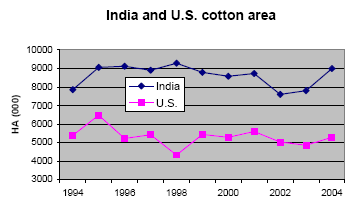 Cotton
area increased in both countries in 2004, although area in India
increased more year-to-year. Indian cotton area generally
fluctuates in response to prices but has been trending downward
in recent years. Cotton
area increased in both countries in 2004, although area in India
increased more year-to-year. Indian cotton area generally
fluctuates in response to prices but has been trending downward
in recent years.
In 2003/04, the trend reversed
itself and area increased approximately 1.2 million hectares.
Area increased in most states from 03/04 to 04/05 with Andhra
Pradesh increasing the most at 38 percent.
The distribution of cotton area
among states changed little year-to year. The central states of
Maharashtra, Gujarat, and Madhya Pradesh continue to plant
approximately 63 percent of India’s total cotton area.
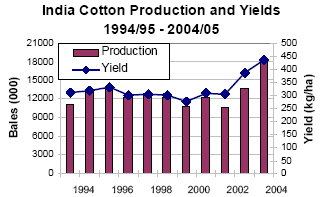 Overall
yields have increased rapidly over the last two years. Yields
prior to the 2003/04 season did not vary much from year-to-year
as can be seen in the graph at right. Yields in 2003/04
increased unexpectedly a little over 26 percent from the prior
year and the 10-year average(1). Overall
yields have increased rapidly over the last two years. Yields
prior to the 2003/04 season did not vary much from year-to-year
as can be seen in the graph at right. Yields in 2003/04
increased unexpectedly a little over 26 percent from the prior
year and the 10-year average(1).
Likewise, forecast yields in
2004/05 continued an upward trend increasing 13 percent over the
previous year’s record and 39 percent above the 10-year average.
The Government of India (GOI) first approved the use of Bt
cotton in 2002 in the central and southern states. Area sewn
with Bt cotton seed is expanding, growing from approximately
40,000 ha in 2002, to 100,000 ha in 2003 and 550,000 ha in 2004.
In addition, high-yielding hybrid seeds are increasingly being
planted across India.
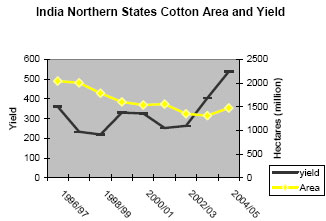 The
GOI recently approved the use of Bt cotton seed in the Northern
states, Punjab, Haryana, and Rajasthan. However, several sources
indicate that Bt cotton seed had already been planted before
approval was given in these areas, perhaps up to 50 percent of
the Northern area. Although cotton area in 2004 only increased
12 percent in this region, yields increased 33 percent resulting
in a production increase of nearly 22 percent. Therefore,
improved yields played a more significant role in the Northern
States 1.4 million bale (170 kg) increase in production(2). The
GOI recently approved the use of Bt cotton seed in the Northern
states, Punjab, Haryana, and Rajasthan. However, several sources
indicate that Bt cotton seed had already been planted before
approval was given in these areas, perhaps up to 50 percent of
the Northern area. Although cotton area in 2004 only increased
12 percent in this region, yields increased 33 percent resulting
in a production increase of nearly 22 percent. Therefore,
improved yields played a more significant role in the Northern
States 1.4 million bale (170 kg) increase in production(2).
This increase represents 22
percent of the total Indian year-over-year increase in
production of 4.2 million bales. To the extent that farmers
switch to the legally approved varieties and continue to adopt
the technology, yields can be expected to grow somewhat in the
coming years. The crops in the North are already irrigated, so
any improvement in seed technology will only enhance production
in these areas.
The State with the largest area
planted to cotton over the last 10 years is Maharashtra located
in the Central zone. Maharashtra generally sows about a third of
the country’s cotton area. However, yields are the lowest in the
country historically. Yields in 2004 increased an estimated 66
percent in this State. This increase is significant, however
yields only reached an estimated 291 kg/ha, well below the
country’s average of 435 kg/ha. The Central and Southern states
crops are dependant on the timing of the monsoon.
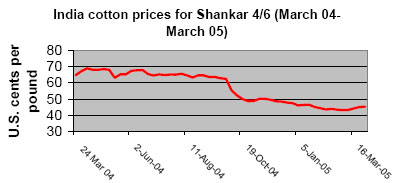 As
a result of this season’s unusual monsoon rainfall pattern,
sowing in these states was extended through early September
compared to the normal end of sowing in late-July. Also
supporting higher yields was this season’s alternating periods
of precipitation followed by several days of sunshine creating
environmental conditions unfavorable for pest proliferation. The
combination of improved seed varieties (including Bt) and better
than average weather helped boost yields. Any technological
improvement in this state could have a significant affect on the
country’s future cotton production. As
a result of this season’s unusual monsoon rainfall pattern,
sowing in these states was extended through early September
compared to the normal end of sowing in late-July. Also
supporting higher yields was this season’s alternating periods
of precipitation followed by several days of sunshine creating
environmental conditions unfavorable for pest proliferation. The
combination of improved seed varieties (including Bt) and better
than average weather helped boost yields. Any technological
improvement in this state could have a significant affect on the
country’s future cotton production.
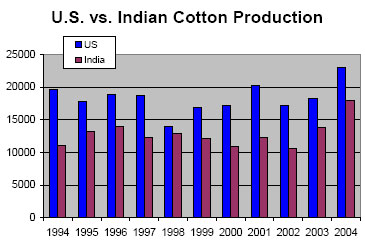 Although
average domestic prices in India are approximately 25 percent
lower than a year ago for a typical cotton variety, yield
increases may partially offset any financial losses. Cotton area
is likely to decline in 2005 somewhat as some crop switching is
likely to occur, perhaps to more profitable crops such as
oilseeds. Although
average domestic prices in India are approximately 25 percent
lower than a year ago for a typical cotton variety, yield
increases may partially offset any financial losses. Cotton area
is likely to decline in 2005 somewhat as some crop switching is
likely to occur, perhaps to more profitable crops such as
oilseeds.
Both the United States and India
are forecast at record cotton yields and production in 2004/05.
The U.S. is forecast at a record high of 23.1 million bales,
while India is forecast at record high of 18 million bales. As a
comparison, while Indian cotton yields are a little less than
half of U.S. yields, India planted close to 41 percent more area
to cotton than the United States. India’s forecast record
production of 18 million bales this year has surpassed the
United States 10-year average production of 17.9 million bales.
If India yields continue to improve at the same rate as it has
in the last two years, using average area, India cotton
production could surpass the United States as the second largest
cotton producer in the world behind China.
(1) Overall
yields in 2002/03 averaged 304 kg/ha, which coincidently, is
equal to the prior 10-year average.
(2) It must be noted that Bt
cotton seed reduces yield losses caused by bollworm infestations
that have historically attacked the Indian and other developing
countries cotton crop. Although the price for the Bt seed is
greater, typically cost savings due to reduced pesticide use
offsets the farmers increased cost for seed. The seed is
generally not sold as a high yielding variety; rather it is sold
as a yield loss reducer.
This report in PDF format:
http://www.fas.usda.gov/pecad/highlights/2005/04/india_web_update.pdf
|